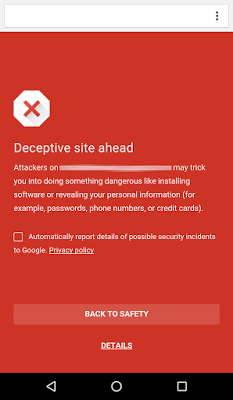
Google has tuned its desktop malware alert service Safe Browsing for mobile and says it’s will not to suck up a smartphone's battery or data.
On smartphones the bigger worry has traditionally been malicious apps, but as Google nudges the world towards the mobile web, it is also looking to tackle malware and phishing threats in mobile browsers.
Google announced today that it is switching on a mobile-optimised version of Google Safe Browsing for Android, which actually first appeared in Chrome 46 that was released in October.
Users of Chrome, Apple’s Safari and Mozilla’s Firefox on the desktop will likely be familiar with red box warnings when they’ve stumbled on a potentially malicious site. Those sites are on Google’s Safe Browsing list of domains known to trick visitors into installing malware or steal personal information.
For the past five years Google has issued tens of millions of phishing and malware warnings each week on desktop browsers, however its Safe Browsing transparency report shows that weekly warnings shot up to 100 million by October 25 and 236 million by November 22. Its not clear whether Chrome on Android was responsible for the sudden increase.
According to the company, Safe Browsing protects more than 1.1 billion desktop browser users while the new service for Android will cover “hundreds of millions” more.
As with the desktop service, Google appears to be preparing for it to support use in multiple browsers, noting that the “first app” to use it is Chrome 46.
A new Safe Browsing client appeared in Google Play Services (GPS) version 8.1, which was released a few months ago. Google uses GPS to keep its apps updated and enable Android services for developers.
Read more: The week in security: Place your security best for 2016
As to why Google is introducing the service now, the company highlighted that malicious apps are not the only threat.
It also needed to overcome a few technical challenges to bring a service that was designed for the desktop to support network- and battery-constrained mobile devices.
“We need to keep an up-to-date list of bad sites on the device to make sure we can warn people before they browse into a trap. Providing this protection on a mobile device is much more difficult than on a desktop system, in no small part because we have to make sure that list doesn’t get stale,” the Google teams said.
To get around these constraints, it appears the number of sites on its list will be reduced based on relevance and risk to achieve “maximum protection per bit”.
Read more: Adobe tells web developers to quit Flash, hacker's favourite target
“Some social engineering attacks only happen in certain parts of the world, so we only send information that protects devices in the geographic regions they’re in,” the Google teams explained.
“We also make sure that we send information about the riskiest sites first: if we can only get a very short update through, as is often the case on lower-speed networks in emerging economies, the update really has to count. We also worked with Google’s compression team to make the little data that we do send as small as possible,” they added.
The teams also made sure the software on the device was “extra stingy with memory and processor use, and careful about minimizing network traffic.”
All of these details matter to us; we must not waste our users’ data plans, or a single moment of their battery life.”
Participate in CSO and Gigamon's survey on Security Priorities today!
For full terms and conditions click here.